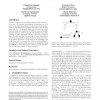Free Online Productivity Tools
i2Speak
i2Symbol
i2OCR
iTex2Img
iWeb2Print
iWeb2Shot
i2Type
iPdf2Split
iPdf2Merge
i2Bopomofo
i2Arabic
i2Style
i2Image
i2PDF
iLatex2Rtf
Sci2ools
KDD
2010
ACM
2010
ACM
Finding effectors in social networks
Assume a network (V, E) where a subset of the nodes in V are active. We consider the problem of selecting a set of k active nodes that best explain the observed activation state, under a given information-propagation model. We call these nodes effectors. We formally define the k-Effectors problem and study its complexity for different types of graphs. We show that for arbitrary graphs the problem is not only NP-hard to solve optimally, but also NP-hard to approximate. We also show that, for some special cases, the problem can be solved optimally in polynomial time using a dynamicprogramming algorithm. To the best of our knowledge, this is the first work to consider the k-Effectors problem in networks. We experimentally evaluate our algorithms using the DBLP co-authorship graph, where we search for effectors of topics that appear in research papers. Categories and Subject Descriptors G.2.2 [Discrete Mathematics]: Graph Theory— ory˚UGraph algorithms; H.2.8 [Database Management]:...
| Added | 29 Jan 2011 |
| Updated | 29 Jan 2011 |
| Type | Journal |
| Year | 2010 |
| Where | KDD |
| Authors | Theodoros Lappas, Evimaria Terzi, Dimitrios Gunopulos, Heikki Mannila |
Comments (0)

